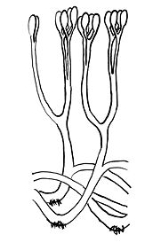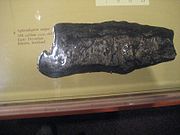
Aglaophyton
Encyclopedia
Aglaophyton major was the sporophyte
generation of a diplohaplontic, pre-vascular, axial, free-sporing land plant of the Lower Devonian (Pragian stage, around ). It had anatomical
features intermediate between those of the bryophyte
s and vascular plants or tracheophytes.
A. major was first described by Kidston and Lang in 1920 as the new species Rhynia major. The species is known only from the Rhynie chert
in Aberdeenshire
, Scotland
, where it grew in the vicinity of a silica-rich hot spring
, together with a number of associated vascular plants such as a smaller species Rhynia gwynne-vaughanii which may be interpreted as a representative of the ancestors of modern vascular plants and Asteroxylon mackei
, which was an ancestor of modern clubmosses (Lycopsida).
 The stems of Aglaophyton were round in cross-section, smooth, unornamented, and up to about 6mm in diameter. Kidston and Lang interpreted the plant as growing upright, to about 50 cm in height, but Edwards has re-interpreted it as having prostrate habit, with shorter aerial axes of about 15 cm height. The axes branched dichotomously, the aerial axes branching at a comparatively wide angle of up to 90°, and were terminated with elliptical, thick-walled sporangia, which when mature, opened by spiral slits, so that the sporangia appear to be spiral in form. Sporangia contained many identical spores (isospores) bearing trilete marks. The spores may therefore be interpreted as meiospores, the product of meiotic divisions, and thus the plants described by Edwards and by Kidston and Lang were diploid, sporophytes. The plant was originally interpreted as a tracheophyte, because the stem has a simple central vascular cylinder or protostele, but more recent interpretations in the light of additional data indicated that Rhynia major had water-conducting tissue lacking the secondary thickening bars seen in the xylem of Rhynia gwynne-vaughanii, more like the water-conducting system (hydrome) of moss
The stems of Aglaophyton were round in cross-section, smooth, unornamented, and up to about 6mm in diameter. Kidston and Lang interpreted the plant as growing upright, to about 50 cm in height, but Edwards has re-interpreted it as having prostrate habit, with shorter aerial axes of about 15 cm height. The axes branched dichotomously, the aerial axes branching at a comparatively wide angle of up to 90°, and were terminated with elliptical, thick-walled sporangia, which when mature, opened by spiral slits, so that the sporangia appear to be spiral in form. Sporangia contained many identical spores (isospores) bearing trilete marks. The spores may therefore be interpreted as meiospores, the product of meiotic divisions, and thus the plants described by Edwards and by Kidston and Lang were diploid, sporophytes. The plant was originally interpreted as a tracheophyte, because the stem has a simple central vascular cylinder or protostele, but more recent interpretations in the light of additional data indicated that Rhynia major had water-conducting tissue lacking the secondary thickening bars seen in the xylem of Rhynia gwynne-vaughanii, more like the water-conducting system (hydrome) of moss
sporophyte
s. Edwards demoted the species to the status of a non-vascular plant and re-named it Aglaophyton major.
Aglaophyton is among the first plants known to have had a mycorrhiza
l relationship with fungi, which formed arbuscules
in a well-defined zone in the cortex of its stems. Aglaophyton lacked root
s, and like other rootless land plants of the Silurian and early Devonian may have relied on mycorrhizal fungi for acquisition of water and nutrients from the soil.
The male gametophyte
of the species has been formally described, which was assigned to a new form taxon Lyonophyton rhyniensis, but is now properly referred to as an Aglaophyton gametophyte. The Rhynie chert
bears many examples of male and female gametophytes, which are loosely similar in their construction to the sporophyte phase, down to bearing rhizoids.
, but rather conducting tissue more similar to that of bryophyte
s. As the diagnosis of Rhynia was that it was a vascular plant
, he created a new genus, Aglaophyton, for this species. (Other species of Rhynia, such as R. gwynne-vaughanii, were not affected.) As Rhynia major the species had been placed in the rhyniophytes, but no alternative higher level classification was proposed for the new genus.
for the polysporangiophytes which places Aglaophyton as a sister of the vascular plants (tracheophytes), with the Horneophytopsida
being sister to both. The basis of the cladogram is that Aglaophyton has more developed conducting tissue than the Horneophytopsida, but does not have true vascular tissue.
Sporophyte
All land plants, and some algae, have life cycles in which a haploid gametophyte generation alternates with a diploid sporophyte, the generation of a plant or algae that has a double set of chromosomes. A multicellular sporophyte generation or phase is present in the life cycle of all land plants...
generation of a diplohaplontic, pre-vascular, axial, free-sporing land plant of the Lower Devonian (Pragian stage, around ). It had anatomical
Plant anatomy
Plant anatomy or phytotomy is the general term for the study of the internal structure of plants. While originally it included plant morphology, which is the description of the physical form and external structure of plants, since the mid-20th century the investigations of plant anatomy are...
features intermediate between those of the bryophyte
Bryophyte
Bryophyte is a traditional name used to refer to all embryophytes that do not have true vascular tissue and are therefore called 'non-vascular plants'. Some bryophytes do have specialized tissues for the transport of water; however since these do not contain lignin, they are not considered to be...
s and vascular plants or tracheophytes.
A. major was first described by Kidston and Lang in 1920 as the new species Rhynia major. The species is known only from the Rhynie chert
Rhynie chert
The Rhynie chert is an Early Devonian sedimentary deposit exhibiting extraordinary fossil detail or completeness . It is exposed near the village of Rhynie, Aberdeenshire, Scotland; a second unit, the Windyfield chert, is located some 700 m away...
in Aberdeenshire
Aberdeenshire
Aberdeenshire is one of the 32 unitary council areas in Scotland and a lieutenancy area.The present day Aberdeenshire council area does not include the City of Aberdeen, now a separate council area, from which its name derives. Together, the modern council area and the city formed historic...
, Scotland
Scotland
Scotland is a country that is part of the United Kingdom. Occupying the northern third of the island of Great Britain, it shares a border with England to the south and is bounded by the North Sea to the east, the Atlantic Ocean to the north and west, and the North Channel and Irish Sea to the...
, where it grew in the vicinity of a silica-rich hot spring
Hot spring
A hot spring is a spring that is produced by the emergence of geothermally heated groundwater from the Earth's crust. There are geothermal hot springs in many locations all over the crust of the earth.-Definitions:...
, together with a number of associated vascular plants such as a smaller species Rhynia gwynne-vaughanii which may be interpreted as a representative of the ancestors of modern vascular plants and Asteroxylon mackei
Asteroxylon
Asteroxylon is an extinct genus of plants of the Division Lycopodiophyta known from anatomically preserved specimens in an Early Devonian deposit of chert at Rhynie, Aberdeenshire in North-East Scotland that has been dated at...
, which was an ancestor of modern clubmosses (Lycopsida).
Description

Moss
Mosses are small, soft plants that are typically 1–10 cm tall, though some species are much larger. They commonly grow close together in clumps or mats in damp or shady locations. They do not have flowers or seeds, and their simple leaves cover the thin wiry stems...
sporophyte
Sporophyte
All land plants, and some algae, have life cycles in which a haploid gametophyte generation alternates with a diploid sporophyte, the generation of a plant or algae that has a double set of chromosomes. A multicellular sporophyte generation or phase is present in the life cycle of all land plants...
s. Edwards demoted the species to the status of a non-vascular plant and re-named it Aglaophyton major.
Aglaophyton is among the first plants known to have had a mycorrhiza
Mycorrhiza
A mycorrhiza is a symbiotic association between a fungus and the roots of a vascular plant....
l relationship with fungi, which formed arbuscules
Arbuscular mycorrhiza
An arbuscular mycorrhiza is a type of mycorrhiza in which the fungus penetrates the cortical cells of the roots of a vascular plant....
in a well-defined zone in the cortex of its stems. Aglaophyton lacked root
Root
In vascular plants, the root is the organ of a plant that typically lies below the surface of the soil. This is not always the case, however, since a root can also be aerial or aerating . Furthermore, a stem normally occurring below ground is not exceptional either...
s, and like other rootless land plants of the Silurian and early Devonian may have relied on mycorrhizal fungi for acquisition of water and nutrients from the soil.
The male gametophyte
Gametophyte
A gametophyte is the haploid, multicellular phase of plants and algae that undergo alternation of generations, with each of its cells containing only a single set of chromosomes....
of the species has been formally described, which was assigned to a new form taxon Lyonophyton rhyniensis, but is now properly referred to as an Aglaophyton gametophyte. The Rhynie chert
Rhynie chert
The Rhynie chert is an Early Devonian sedimentary deposit exhibiting extraordinary fossil detail or completeness . It is exposed near the village of Rhynie, Aberdeenshire, Scotland; a second unit, the Windyfield chert, is located some 700 m away...
bears many examples of male and female gametophytes, which are loosely similar in their construction to the sporophyte phase, down to bearing rhizoids.
Taxonomy
Aglaophyton major was first described as Rhynia major by Kidston and Lang in 1920. In 1986 D.S. Edwards re-examined fossil specimens and reported that they did not contain true vascular tissueVascular tissue
Vascular tissue is a complex conducting tissue, formed of more than one cell type, found in vascular plants. The primary components of vascular tissue are the xylem and phloem. These two tissues transport fluid and nutrients internally. There are also two meristems associated with vascular tissue:...
, but rather conducting tissue more similar to that of bryophyte
Bryophyte
Bryophyte is a traditional name used to refer to all embryophytes that do not have true vascular tissue and are therefore called 'non-vascular plants'. Some bryophytes do have specialized tissues for the transport of water; however since these do not contain lignin, they are not considered to be...
s. As the diagnosis of Rhynia was that it was a vascular plant
Vascular plant
Vascular plants are those plants that have lignified tissues for conducting water, minerals, and photosynthetic products through the plant. Vascular plants include the clubmosses, Equisetum, ferns, gymnosperms and angiosperms...
, he created a new genus, Aglaophyton, for this species. (Other species of Rhynia, such as R. gwynne-vaughanii, were not affected.) As Rhynia major the species had been placed in the rhyniophytes, but no alternative higher level classification was proposed for the new genus.
Phylogeny
In 2004, Crane et al. published a cladogramCladogram
A cladogram is a diagram used in cladistics which shows ancestral relations between organisms, to represent the evolutionary tree of life. Although traditionally such cladograms were generated largely on the basis of morphological characters, DNA and RNA sequencing data and computational...
for the polysporangiophytes which places Aglaophyton as a sister of the vascular plants (tracheophytes), with the Horneophytopsida
Horneophytopsida
Horneophytopsida is a class of extinct plants which consisted of branched stems without leaves, true roots or vascular tissue, found from the Late Silurian to the Early Devonian . They are the simplest known polysporangiophytes, i.e. plants with sporophytes bearing many spore-forming organs on...
being sister to both. The basis of the cladogram is that Aglaophyton has more developed conducting tissue than the Horneophytopsida, but does not have true vascular tissue.
External links
- Cladogram from

